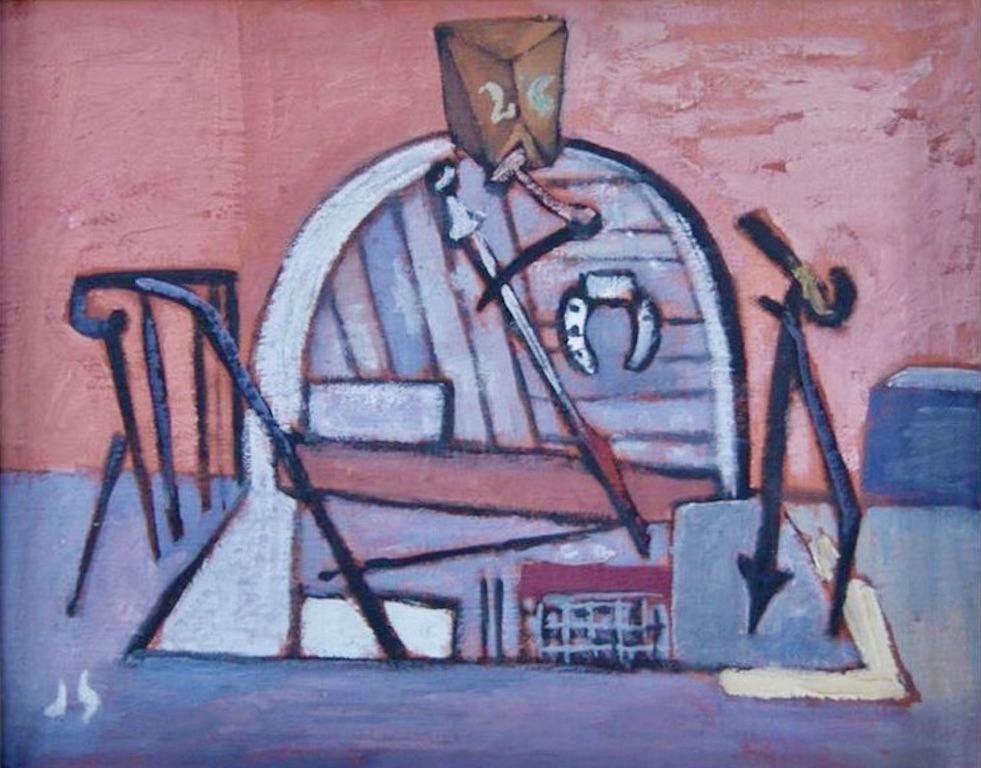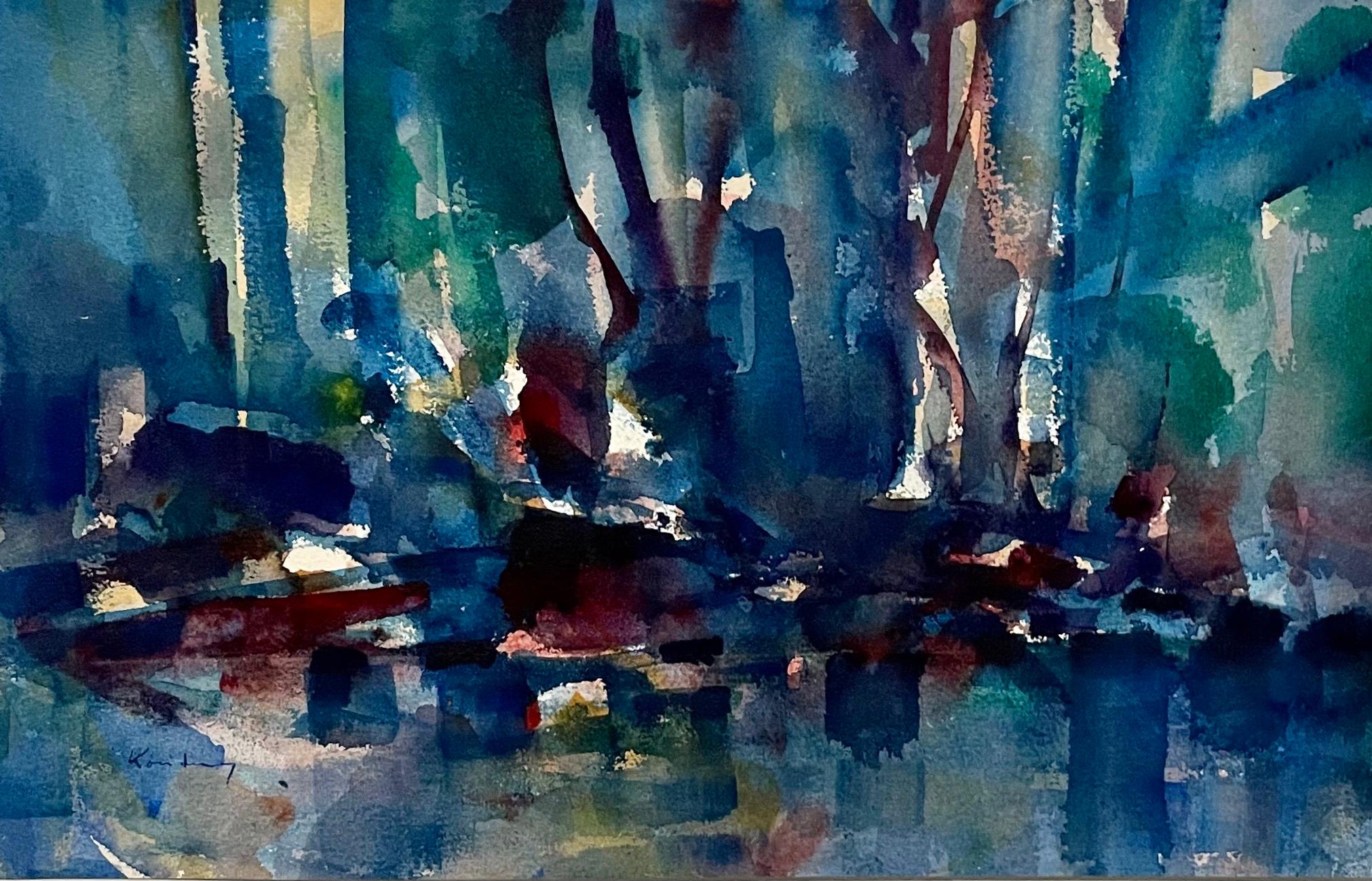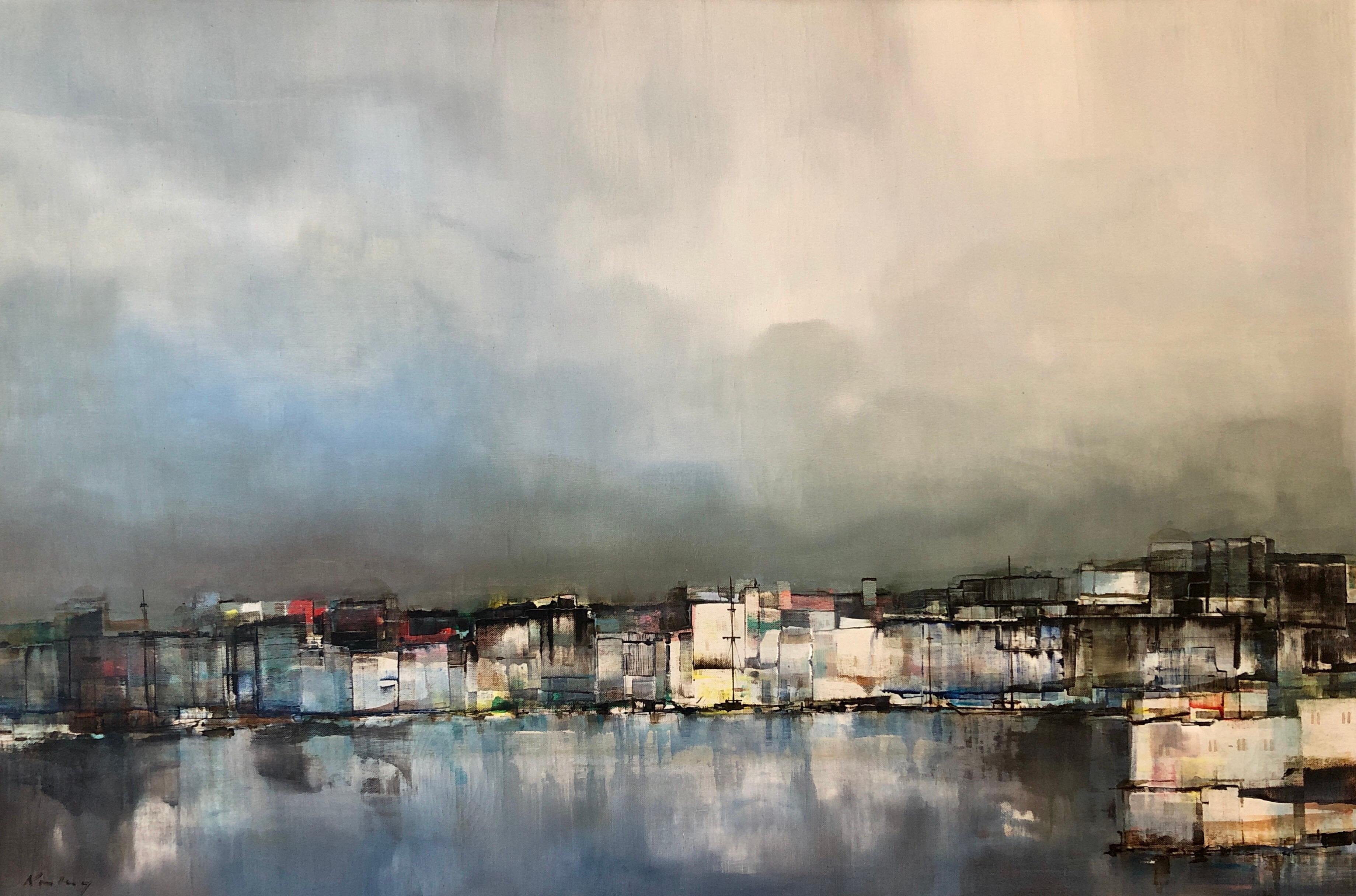Items Similar to American Modernist Abstract Landscape Oil Painting of Trees, Yellow Orange Blue
Video Loading
Want more images or videos?
Request additional images or videos from the seller
1 of 18
Henriette "Yetti" StolzAmerican Modernist Abstract Landscape Oil Painting of Trees, Yellow Orange Blue
About the Item
Mid 20th Century abstracted landscape pen and oil painting with trees by American Modernist Henriette "Yetti" Stolz, signed on the back of the painting. Portrays a modernist landscape of a forest with trees, painted in shades of gold, brown, orange, and blue. Presented in a vintage frame measuring 30 ¾ x 36 ¼ inches. Image measures 30 ¼ x 35 ¾ inches.
Provenance: Estate of the Artist, Henriette "Yetti" Stolz
Painting is in good condition - please contact us for a detailed condition report.
About the Artist:
Henriette “Yetti” Stolz was born in Serbia in 1935 ( and is still living ). Her family emigrated to Denver, Colorado, in the early 1950s after WWII and she attended East High School before studying art at Colorado College, in Colorado Springs in the mid to late 50s. While there studying she would have been exposed to modernist artists working both at the college ( ie. Mary Chenoweth ) as well as the Broadmoor Art Academy. She presumably must have known Emerson Woelffer while he worked at the Colorado Springs Fine Arts Center as her work seems to be heavily influenced by what he was producing in the 1950s. In 1957 she married Don Gruenler and soon after began teaching Art, German, and Jewelry Making at Thomas Jefferson High School in Denver. She participated in a couple small art shows as an adult but seemingly didn’t produce or sell a lot of art.
- Creator:Henriette "Yetti" Stolz
- Dimensions:Height: 30.75 in (78.11 cm)Width: 36.25 in (92.08 cm)Depth: 1.25 in (3.18 cm)
- Medium:
- Movement & Style:
- Period:
- Framing:Frame IncludedFraming Options Available
- Condition:
- Gallery Location:Denver, CO
- Reference Number:
About the Seller
5.0
Platinum Seller
These expertly vetted sellers are 1stDibs' most experienced sellers and are rated highest by our customers.
Established in 1979
1stDibs seller since 2013
265 sales on 1stDibs
Typical response time: 3 hours
- ShippingRetrieving quote...Ships From: Denver, CO
- Return PolicyA return for this item may be initiated within 7 days of delivery.
More From This SellerView All
- Central City, Colorado, 1950s Modernist Cityscape Oil Painting with BuildingsLocated in Denver, COOil on canvas modernist city scape painted circa 1950 by Paul K Smith (1893-1977) titled Central City, Colorado. Portrays a city scene of historic buildin...Category
1950s American Modern Landscape Paintings
MaterialsCanvas, Oil
- Mid Century Modern Abstracted Cityscape Oil Painting, American Modern, Red BlackLocated in Denver, COMid 20th century oil and spackle painting featuring an abstracted cityscape with a bridge and buildings by Henriette "Yetti" Stolz. Signed by the artist in the lower right margin. Pa...Category
Mid-20th Century American Modern Abstract Paintings
MaterialsOil, Board, Putty
- Southwestern Landscape Painting, Lightning Storm over Mountains, Semi AbstractLocated in Denver, COOriginal vintage painting of a Lightning Storm, Southwestern Mountain Landcape. Oil painting on textured board by Morton Lawrence Schneider (1919-2000). This large scale semi abstrac...Category
20th Century American Modern Landscape Paintings
MaterialsOil, Board
- Ed Sketching at Red Rocks, Vintage 1940s Original Mountain Landscape, ColoradoBy Vance KirklandLocated in Denver, COOriginal vintage 1940s Modernist Landscape painting of Red Rocks Park, Colorado by Vance Kirkland (1904-1981). Titled, "Ed (Hicks) Sketching at Red Rocks". This regionalist mountain landscape painting is set near Red Rocks Park, Morrison, Colorado (just west of Denver). The figure in the painting is of Kirkland's friend, Ed Hicks. Watercolor on paper, signed and dated, January 1943, lower left and titled verso by the artist. Painted in colors of red, brown, blue, and green. Presented in a custom gold leaf frame, outer dimensions measure 34 ¾ x 42 ⅞ x 1 ¼ inches. Painting as shown within the mat and frame measures 21 x 29 inches. Provenance: Private Collection, Denver, Colorado About the Artist: Variously referred to as the “Father of Modern Colorado Painting,” “Dean of Colorado Artists” and “Colorado’s pre-eminent artist,” Kirkland was an inventive, visionary painter who spent fifty-two years of his fifty-four year career in Denver. Of the approximately 1,200 paintings he created, about 550 from the first half of his career (1927-1953) are water-based media: acquarelle, gouache, casein and egg tempera, with a few oils. In the latter half of his career (1953-1981) he used oil and his unique oil and water mixture. He also produced five hundred drawings and some ten prints, mostly lithographs on stone, while also engaged in teaching full-time for most of the period. To show people “something they have never seen before and new ways to look at things,” he felt he needed to preserve his artistic freedom. Consequently, he chose to spend his entire professional career in Denver far removed from the established American art centers in the East and Midwest. “By minding my own business and working on my own,” he said, “I think it was possible to develop in this part of the country… I’ve developed my kind of work [and] I think my paintings are stronger for having worked that way.” The geographical isolation resulting from his choice to stay in Colorado did not impede his creativity, as it did other artists, but in fact contributed to his unique vision. The son of a dentist, who was disappointed with his [son’s] choice of art as a career, Kirkland flunked freshman watercolor class in 1924 at the Cleveland School of Art (now the Cleveland Institute of Art) for putting colors into his landscapes that did not exist in nature and for competing colors. Not dissuaded, he won first prize for his watercolors in his junior and senior years. [While in Cleveland,] he studied with three influential teachers. Henry Keller, included in the prestigious New York Armory Show in 1913, introduced him to designed realism which he later used in his Colorado landscapes in the 1930s and 1940s. His other teachers were Bill Eastman, who studied with Hans Hofmann and appreciated all the new movements in modern art, and Frank Wilcox, a fine watercolorist. While a student at the Cleveland School of Art, Kirkland concurrently took liberal arts courses at Western Reserve and the Cleveland School of Education and taught two freshman courses in watercolor and design, receiving his diploma in painting from the school in 1927 by doing four years of work in three. The following year he received a Bachelor of Education in Art degree from the same institution. In 1929 he assumed the position of founding director of the University of Denver’s School of Art, originally known as the Chappell School of Art. He resigned three years later when the university reneged on its agreement to grant its art courses full recognition toward a Bachelor of Arts degree. His students prevailed on him to continue teaching, resulting in the Kirkland School of Art which he opened in 1932 at 1311 Pearl Street in Denver. The building, where he painted until his death in 1981, formerly was the studio of British-born artist, Henry Read, designer of the City of Denver Seal and one of the original thirteen charter members of the Artists’ Club of Denver, forerunner of the Denver Art Museum. The Kirkland School of Art prospered for the next fourteen years with its courses accredited by the University of Colorado Extension Center in Denver. The teaching income from his art school and his painting commissions helped him survive the Great Depression. The U.S. Treasury Department’s Section of Fine Arts commissioned from him two post office murals, Cattle Roundup (1938, Eureka, Kansas), and Land Rush (1940, Sayre, Oklahoma). He also did murals for several Denver clients: the Gerald Hughes mansion (1936, later demolished), Arthur Johnson home (1936-37, Seven Drinks of Man), Albany Hotel (1937, later demolished), Neustetter’s Department Store (1937, “History of Costume,” three of five saved in 1987 before the building interior was demolished in advance of its condo conversion), and the Denver Country Club (1945, partially destroyed and later painted over). In 1953 the Ford Times, published by the Ford Motor Company, commissioned Kirkland along with fellow Denver artists, William Sanderson and Richard Sorby, to paint six watercolors each for the publication. Their work appeared in articles [about] Colorado entitled, “Take to the High Road” (of the Colorado Rockies) by Alicita and Warren Hamilton. Kirkland sketched the mountain passes and high roads in the area of Mount Evans, Independence Pass near Aspen, and Trail Ridge Road in Rocky Mountain National Park. In 1946 Kirkland closed his art school when the University of Denver rehired him as director of its School of Art and chairman of the Division of Arts and Humanities. In 1957...Category
1940s American Modern Landscape Paintings
MaterialsWatercolor
- Central City, Colorado, 1950s Semi-Abstract Cityscape Gouache Painting, Red BlueLocated in Denver, CO'Central City, Colorado' by Leonard Silverstein is an original gouache on paper from 1954. Hand signed, titled, and dated by the artist in the lower right...Category
1950s American Modern Landscape Paintings
MaterialsGouache, Archival Paper
- Old Mine and Houses, Cortez Colorado, Modernist Abstract Landscape WatercolorBy Richard AyerLocated in Denver, CO20th century modernist watercolor painting depicting an old mine and houses in Cortez, Colorado by Richard K. Ayers with colors of blue, green, gold, and brown. Presented in a custom frame with all archival materials, outer dimensions measure 36 ½ x 30 ½ x ¾ inches. Image size is 24 ¾ x 18 ¾ inches. Painting is clean and in very good vintage condition. About the Artist: Richard K. Ayers (1921-2003) studied art at Miami University...Category
20th Century American Modern Abstract Paintings
MaterialsWatercolor
You May Also Like
- WPA American Scene Modernism 20th Century NYC Industrial "Cellar with Horseshoe"By Joseph SolmanLocated in New York, NY"Cellar with Horseshoe" WPA American Scene Modernism 20th Century NYC Industrial Joseph Solman (1909-2008) "Cellar with Horseshoe," 16 x 20 inches, oil on canvas circa 1938, initial...Category
1930s American Modern Landscape Paintings
MaterialsCanvas, Oil
- Orbs, Spiritual and Abstract LandscapeLocated in Doylestown, PA"Orbs" is a 38 x 50 inches, oil on canvas painting by American modernist and surrealist, female artist Peter Miller. The work is estate stamped 202141 on verso. The painting has been...Category
1950s American Modern Abstract Paintings
MaterialsCanvas, Oil
- Salutations, Architectural Abstract Scene, Cultural and Spiritual CommentaryLocated in Doylestown, PA"Salutations" is a 12 x 16 inches, oil on canvas painting by American modernist and surrealist, female artist Peter Miller. The work is painted in a vibrant color palette. The painti...Category
1940s American Modern Abstract Paintings
MaterialsCanvas, Oil
- Forest, American Modernist Abstract Landscape Painting by Female ArtistLocated in Doylestown, PA"Forest" is a 29 x 36 inches, oil on canvas painting by American modernist, female artist Peter Miller. The work is painted in a vibrant color palette. The work is estate stamped on ...Category
1940s American Modern Abstract Paintings
MaterialsCanvas, Oil
- Modernist Abstract Expressionist Watercolor Painting Bauhaus Weimar Pawel KontnyBy Pawel KontnyLocated in Surfside, FLAbstract watercolor composition bearing the influence of the earlier color-block compositions of Paul Klee. Pawel August Kontny, (Polish-German-American artist) He was born in Laurahuette, Poland, in 1923, the son of a wealthy pastry shop owner. In 1939 he began studying architecture in Breslau where he was introduced to the European masters and to the work of some of the German Expressionists, soon afterward banned as "degenerate artists" and removed from museums throughout Germany by the Nazi regime. His studies were interrupted by World War II. Drafted into the German army, traveling in many countries as a soldier, he sketched various landscapes but in 1945, he was captured and held as a prisoner of war in Italy. After the war, he studied at the Union of Nuremberg Architects to help design buildings to replace ones destroyed in the war. He recorded his impressions of the local population and the landscapes through his watercolors and drawings. Pawel Kontny thereafter moved to Nuremberg, Germany, becoming a member of the Union of Nuremberg Architects and helping to rebuild the city's historic center. He soon decided to concentrate on his professional art career. He married Irmgard Laurer, a dancer with the Nuremberg Opera. Pavel Kontny 's career as an artist was launched with his participation in an all German exhibition, held at the Dusseldorf Museum in 1952. He held one-man shows in Germany, Switzerland and the United States. During his trip to the United States in 1960, Kontny became instantly enamored with Colorado, and decided to relocate to Cherry Hills with his wife and two children. He quickly established himself in the local art community, being affiliated for a time with Denver Art Galleries and Saks Galleries. His subject matter became the Southwest. During this time he received the Prestigious Gold Medal of the Art Academy of Rome. His extensive travel provided material for the paintings he did using his hallmark marble dust technique. he also worked equally in pastel, watercolor, charcoal and pencil-and-ink. in a style which merged abstraction and realist styles, influenced by Abstract Expressionist painting and South Western American landscapes. In the early 1960s he was one of only a few European-born professional artists in the state, a select group that included Herbert Bayer (1900-1985), a member of the prewar Bauhaus in Weimar and Dessau, Germany, and Roland Detre (1903-2001), a Hungarian modernist painter. As a Denver, Colorado resident, Pavel Kontny exhibited at galleries and museums throughout the United States, Germany and Japan. There, he was inspired by frequent trips to Native American pueblos in the Southwest, as well as by the study of the Plains Indians of Montana and Wyoming. Over the years Kontny had a number of students and generously helped young artist by hosting exhibitions at his Cherry Hills home. For many years he generously donated his paintings to support charitable causes in Denver. Influences during his European years included German pastelist C.O. Muller, German Informel painter Karl Dahmen and Swiss artist, Hans Erni. In the early 1950s his painting style showed the influence of the Die Brücke (The Bridge), a group of German expressionist artists formed in Dresden in 1905 who had a major impact on the evolution of modern art in the twentieth century in Germany. By the middle of the decade his style incorporated more referential abstraction and total abstraction, resulting in part from his study of Hans Hartung, a German artist based in Paris who exhibited his gestural abstract work in Germany. The American moon landing in 1969 inspired Paul Kontny...Category
20th Century American Modern Landscape Paintings
MaterialsCanvas, Oil
- Modernist Colorado Oil Painting Abstract Cityscape Harbor Scene Pawel KontnyBy Pawel KontnyLocated in Surfside, FLUrban landscape of city harbor, marine scene, (North Africa?) bearing the influence of the earlier color-block compositions of Paul Klee. Modernist Cityscape 24" x 36" sight. oil on ...Category
20th Century American Modern Landscape Paintings
MaterialsCanvas, Oil
Recently Viewed
View AllMore Ways To Browse
American Abstract Oil Paintings
Oil Paintings Of Trees
Abstract Painting American School
Early American Oil Painting
Framed Paintings Of Trees
Retro Orange And Blue
Abstract Tree Painting
Yellow Tree
Mid Modern American Paintings
American Modernist Paintings
Vintage Jewellery Making
American Painting Gold Frame
Trees Painting Blue
Paintings Of Blue Trees
Mid Century American Abstract Painting
American Mid Century Oil Paintings
American Midcentury Oil Painting
Modern Tree Painting


